Ancient China › Silver in Antiquity » Ancient origins
Articles and Definitions › Contents
- Ancient China › Ancient History
- Silver in Antiquity › Ancient History
Ancient civilizations › Historical and archaeological sites
Ancient China › Ancient History
Definition and Origins
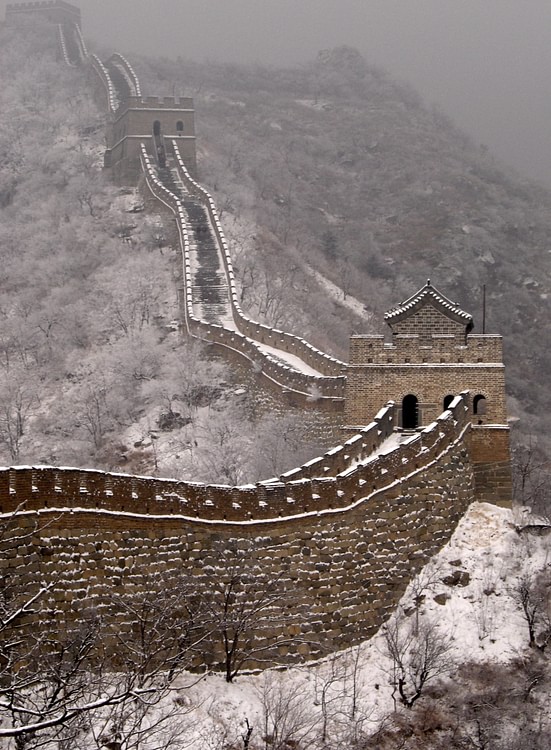
Ancient China produced what has become the oldest, still extant, culture in the world. The name `China' comes from the Sanskrit Cina (derived from the name of the Chinese Qin Dynasty, pronounced `Chin') which was translated as `Cin' by the Persians and seems to have become popularized through trade along the Silk Road from China to the rest of the world. The Romans and the Greeks knew the country as `Seres', “the land where silk comes from”. The name `China' does not appear in print in the west until 1516 CE in Barbosa's journals narrating his travels in the east (though the Europeans had long known of China through trade via the Silk Road). Marco Polo, the famous explorer who familiarized China to Europe in the 13th century CE, referred to the land as `Cathay'. In Mandarin Chinese, the country is known as `Zhongguo” meaning `central state' or `middle empire '.
PRE-HISTORY
Well before the advent of recognizable civilization in the region, the land was occupied by hominids. Peking Man, a skull fossil discovered in 1927 CE near Beijing, lived in the area between 700,000 to 200,000 years ago and Yuanmou Man, whose remains were found in Yuanmou in 1965 CE, inhabited the land 1.7 million years ago. Evidence uncovered with these finds shows that these early inhabitants knew how to fashion stone tools and use fire. While it is commonly accepted that human beings originated in Africa and then migrated to other points around the globe, China's paleoanthropologists “support the theory of `regional evolution' of the origin of man” (China.org) which claims an independent basis for the birth of mankind. “The Shu Ape, a primate weighing only 100 to 150 grams and being similar to a mouse in size, lived [in China] in the Middle Eocene Epoch 4.5 to 4 million years ago. Its discovery posed a great challenge to the theory of African origin of the human race” (China.org). This challenge is considered plausible due to genetic links between the Shu Ape fossil and both advanced and lower primates, standing, then, as a `missing link' in the evolutionary process. However one interprets this data (the Chinese conclusions have been disputed by the international community), the solid evidence provided by other finds substantiates a very ancient lineage of hominids and human beings in China and a high level of sophistication in early culture. One example of this is Banpo Village, near Xi'an, discovered in 1953 CE. Banpo is a Neolithic village which was inhabited between 4500 and 3750 BCE and comprises 45 houses with floors sunk into the ground for greater stability. A trench encircling the village provided both protection from attack and drainage while man-made caves dug underground were used to store food. The design of the village, and the artifacts discovered there (such as pottery and tools), argue for a very advanced culture at the time it was constructed.
It has generally been accepted that the Chinese `Cradle of Civilization' is the Yellow River Valley which gave rise to villages sometime around 5000 BCE. While this has been disputed, and arguments have been made for a more wide-spread development of communities, there is no doubt that the Henan province, in the Yellow River Valley, was the site of many early villages and farming communities. In 2001 CE, archaeologists uncovered two skeletons “buried in a collapsed house, which was covered with a thick layer of silt deposits from the Yellow River. In the layer of deposits, archaeologists found more than 20 skeletons, an altar, a square, pottery, and stone and jade utensils” (Chinapage.org). This site was only one of many prehistoric villages in the area.
THE FIRST DYNASTIES
YU THE GREAT WAS SO FOCUSED ON HIS WORK THAT IT WAS SAID HE DID NOT RETURN HOME ONCE IN ALL THOSE YEARS, EVEN THOUGH HE SEEMS TO HAVE PASSED BY HIS HOUSE ON AT LEAST THREE OCCASIONS...
From these small villages and farming communities grew centralized government; the first of which was the prehistoric Xia Dynasty (c. 2070-1600 BCE). The Xia Dynasty was considered, for many years, more myth than fact until excavations in the 1960's and 1970's CE uncovered sites which argued strongly for its existence. Bronze works and tombs clearly point to an evolutionary period of development between disparate Stone Age villages and a recognizable cohesive civilization. The dynasty was founded by Yu the Great who worked relentlessly for thirteen years to control the flooding of the Yellow River which routinely destroyed the farmer's crops. He was so focused on his work that it was said he did not return home once in all those years, even though he seems to have passed by his house on at least three occasions, and this dedication inspired others to follow him. After he had controlled the flooding, Yu conquered the Sanmiao tribes and was named successor (by the then-ruler, Shun), reigning until his death. Yu established the hereditary system of succession and, so, the concept of dynasty which has become most familiar. The ruling class and the elite lived in urban clusters while the peasant population, which supported their lifestyle, remained largely agrarian, living in rural areas. Yu's son, Qi, ruled after him and power remained in the hands of the family until the last Xia ruler, Jie, was overthrown by Tang who established the Shang Dynasty (1600-1046 BCE).
Tang was from the kingdom of Shang. The dates popularly assigned to him (1675-1646 BCE) do not in any way correspond to the known events in which he took part and must be considered erroneous. What is known is that he was the ruler, or at least a very important personage, in the kingdom of Shang who, around 1600 BCE, led a revolt against Jie and defeated his forces at the Battle of Mingtiao. The extravagance of the Xia court, and the resultant burden on the populace, is thought to have led to this uprising. Tang then assumed leadership of the land, lowered taxes, suspended the grandiose building projects begun by Jie (which were draining the kingdoms of resources) and ruled with such wisdom and efficiency that art and culture were allowed to flourish. Writing developed under the Shang Dynasty as well as bronze metallurgy, architecture, and religion.
Prior to the Shang, the people worshipped many gods with one supreme god, Shangti, as head of the pantheon (the same pattern found in other cultures). Shangti was considered `the great ancestor' who presided over victory in war, agriculture, the weather, and good government. Because he was so remote and so busy, however, the people seem to have required more immediate intercessors for their needs and so the practice of ancestor worship began. When someone died, it was thought, they attained divine powers and could be called upon for assistance in times of need (similar to the Roman belief in the Parentes ). This practice led to highly sophisticated rituals dedicated to appeasing the spirits of the ancestors which eventually included ornate burials in grand tombs filled with all one would need to enjoy a comfortable afterlife. The king, in addition to his secular duties, served as chief officiate and mediator between the living and the dead and his rule was considered ordained by divine law. Although the famous Mandate of Heaven was developed by the later Zhou Dynasty, the idea of linking a just ruler with divine will has its roots in the beliefs fostered by the Shang.
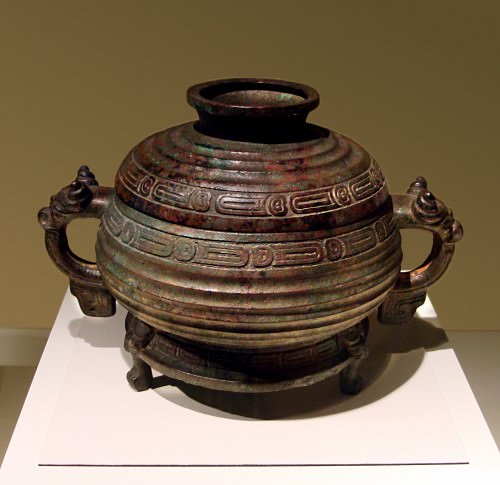
Bronze Zhou Cooking Vessel
THE ZHOU DYNASTY
Around the year 1046 BCE, King Wu, of the province of Zhou, rebelled against King Zhou of Shang and defeated his forces at the Battle of Muye, establishing the Zhou Dynasty (c. 1046- 256 BCE). 1046-771 BCE marks the Western Zhou Period while 771-226 BCE marks the Eastern Zhou Period. The Mandate of Heaven was invoked by the Duke of Zhou, King Wu's younger brother, to legitimize the revolt as he felt the Shang were no longer acting in the interests of the people. The Mandate of Heaven was thus defined as the gods' blessing on a just ruler and rule by divine mandate. When the government no longer served the will of the gods, that government would be overthrown. Further, it was stipulated that there could be only one legitimate ruler of China and that his rule should be legitimized by his proper conduct as a steward of the lands entrusted him by heaven. Rule could be passed from father to son but only if the child possessed the necessary virtue to rule. This mandate would later be often manipulated by various rulers entrusting succession to unworthy progeny.
Under the Zhou, culture flourished and civilization spread. Writing was codified and iron metallurgy became increasingly sophisticated. The greatest and best known Chinese philosophers and poets, Confucius, Mencius, Mo Ti (Mot Zu), Lao-Tzu, Tao Chien, and the military strategist Sun-Tzu (if he existed as depicted), all come from the Zhou period in China and the time of the Hundred Schools of Thought. The chariot, which was introduced to the land under the Shang, became more fully developed by the Zhou. It should be noted that these periods and dynasties did not begin nor end as neatly as they seem to in history books and the Zhou Dynasty shared many qualities with the Shang (including language and religion). While historians find it necessary, for clarity's sake, to break events into periods, the Zhou Dynasty remained extant through the following recognized periods known as The Spring and Autumn Period and The Warring States Period.
THE SPRING & AUTUMN PERIOD & THE WARRING STATES
During the Spring and Autumn Period (772-476 BCE and so called from the Spring and Autumn Annals, the official chronicle of the state at the time and an early source mentioning General Sun-Tzu), the Zhou government became decentralized in their move to the new capital at Luoyang, marking the end of the `Western Zhou' period and the beginning of `Eastern Zhou'. This is the period most noted for advances in philosophy, poetry, and the arts and saw the rise of Confucian, Taoist, and Mohist thought. At the same time, however, the different states were breaking away from central rule by Luoyang and proclaiming themselves sovereign. This, then, led to the so-called Warring States Period (476-221 BCE) in which seven states fought with each other for control. The seven states were Chu, Han, Qi, Qin, Wei, Yan, and Zhao all of whom considered themselves sovereign but none of whom felt confident in claiming the Mandate of Heaven still held by the Zhou of Luoyang. All seven of the states used the same tactics and observed the same rules of conduct in battle and so none could gain the advantage over the others. This situation was exploited by the pacifist philosopher Mo Ti, a skilled engineer, who made it his mission to provide each state with equal knowledge of fortifications and siege ladders in hopes of neutralizing any one state's advantage and so ending the war. His efforts were unsuccessful however and, between 262 and 260 BCE, the state of Qin gained supremacy over Zhao, finally defeating them at The Battle of Changping.
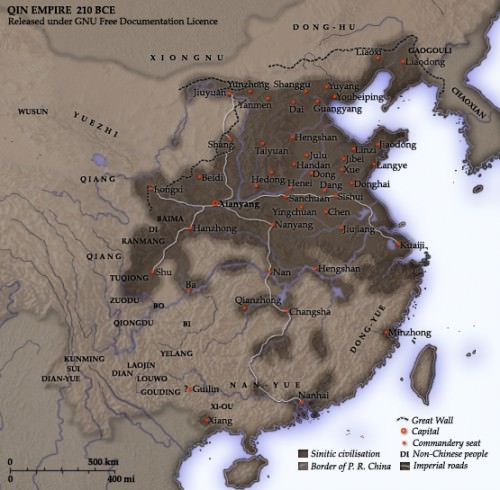
Map of the Qin Empire
THE QIN DYNASTY
Shi Huangdi thus established the Qin Dynasty (221-206 BCE) which is also known as the Imperial Era in China. He ordered the destruction of the walled fortifications which had separated the different states and commissioned the building of a great wall along the northern border of his kingdom. Though little remains today of Shi Huangdi's original wall, The Great Wall of China was begun under his rule.
It stretched for over 5,000 kilometres (3,000 miles) across hill and plain, from the boundaries of Korea in the east to the troublesome Ordos Desert in the west. It was an enormous logistical undertaking, though for much of its course it incorporated lengths of earlier walls built by the separate Chinese kingdoms to defend their northern frontiers in the fourth and third centuries. (Scarre and Fagan, 382).
Shi Huangdi also strengthened the infrastructure through road building which helped to increase trade through ease of travel.
Five trunk roads led from the imperial capital at Xianyang, each provided with police forces and posting stations.Most of these roads were of rammed-earth construction and were 15 metres (50 feet) wide. The longest ran southwest over 7,500 kilometres (4,500 miles) to the frontier region of Yunnan. So precipitous was the countryside that sections of the road had to be built out from vertical cliff faces on projecting timber galleries.(Scarre and Fagan, 382).
Shi Huangdi also expanded the boundaries of his empire, built the Grand Canal in the south, redistributed land and, initially, was a fair and just ruler.
While he made great strides in building projects and military campaigns, his rule became increasingly characterized by a heavy hand in domestic policy. Claiming the Mandate from Heaven, he suppressed all philosophies save the Legalism which had been developed by Shang Yang and, heeding the counsel of his chief advisor, Li Siu, he ordered the destruction of any history or philosophy books which did not correspond to Legalism, his family line, the state of Qin, or himself.
Since books were then written on strips of bamboo fastened with swivel pins, and a volume might be of some weight, the scholars who sought to evade the order were put to many difficulties. A number of them were detected; tradition says that many of them were sent to labor on the Great Wall, and that four hundred and sixty were put to death. Nevertheless some of the literati memorized the complete works of Confucius and passed them on by word of mouth to equal memories. (Durant, 697).
This act, along with Shi Huangdi's suppression of general freedoms, including freedom of speech, made him progressively more unpopular.
The ancestor worship of the past, and the land of the dead, began to interest the emperor more than his realm of the living and Shi Huangti became increasingly engrossed in what this other world consisted of and how he might avoid traveling there. He seems to have developed an obsession with death, became increasingly paranoid regarding his personal safety, and ardently sought after immortality. His desire to provide for himself an afterlife commensurate with his present one led him to commission a palace built for his tomb and an army of over 8,000 terracotta warriors created to serve him in eternity. This ceramic army, buried with him, also included terracotta chariots, cavalry, a commander in chief, and assorted birds and animals. He is said to have died while on a quest for an elixir of immortality and Li Siu, hoping to gain control of the government, kept his death a secret until he could alter his will to name his pliable son, Hu-Hai, as heir. This plan proved untenable, however, as the young prince showed himself to be quite unstable, executing many, and initiating a widespread rebellion in the land. Shortly after Shi Huangdi' s death, the Qin Dynasty quickly collapsed through the intrigue and ineptitude of people like Hu-Hai, Li Siu, and another advisor, Zhao Gao, and the Han Dynasty began with the accession of Liu-Bang.
THE CHU-HAN CONTENTION
With the fall of the Qin Dynasty, China was plunged into chaos. Two generals emerged among the forces which rebelled against the Qin, Prince Liu-Bang of Hanzhong and King Xiang-Yu of the state of Chu, who fought for control of the government. Xiang-Yu, who had proven himself the most formidable opponent of the Qin, awarded Liu-Bang the title of `King of the Han' in recognition of Liu-Bang's decisive defeat of the Qin forces in the final battle. The two former allies quickly became antagonists, however, in the power struggle known as the Chu-Han contention until Xiang-Yu negotiated the Treaty of Hong Canal and brought a temporary peace. Xiang-Yu suggested dividing China under the rule of the Chu in the east and the Han in the west but Liu-Bang wanted a united China under Han rule and, breaking the treaty, resumed hostilities. At the Battle of Gaixia in 202 BCE, Liu-Bang's great general, Han-Xin, trapped and defeated the forces of Chu under Xiang-Yu and Liu-Bang was proclaimed emperor (known to posterity as Emperor Gaozu of Han). Xiang-Yu committed suicide but his family was allowed to live and even serve in government positions. Liu-Bang treated all of his former adversaries with respect and united the land under his rule. He pushed back the nomadic Xiongnu tribes, who had been making incursions into China, and made peace with the other states which had risen in rebellion against the failing Qin Dynasty. The Han Dynasty (which derives its name from Liu-Bang's home in Hanzhong province) would rule China, with a brief interruption, for the next 400 years, from 202 BCE to 220 CE.
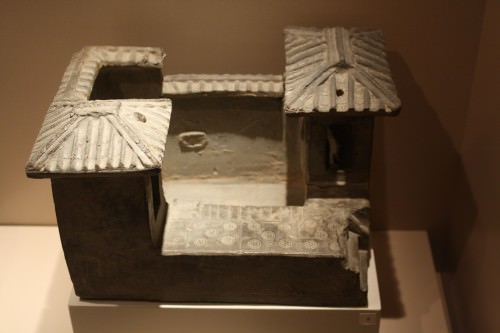
Han Dynasty Farm Model
THE HAN DYNASTY
The resultant peace initiated by Liu-Bang brought the stability necessary for culture to again thrive and grow. Trade with the west began during this time and arts and technology increased in sophistication. The Han are considered the first dynasty to write their history down but, as Shi Huangti destroyed so many of the written records of those who came before him, this claim is often disputed. There is no doubt, however, that great advances were made under the Han in every area of culture. The Yellow Emperor's Canon of Medicine, China's earliest written record on medicine was codified during the Han Dynasty.Gunpowder, which the Chinese had already invented, became more refined. Paper was invented at this time and writing became more sophisticated. Liu-Bang embraced Confucianism and made it the exclusive philosophy of the government, setting a pattern which would continue on to the present day. Even so, unlike Shi Huangti, he practised tolerance for all other philosophies and, as a result, literature and education flourished under his reign. He reduced taxes and disbanded his army who, nevertheless, rallied without delay when called upon.
After his death in 195 BCE, the crown prince Liu Ying succeeded him and continued his policies. These programmes maintained stability and culture enabling the greatest of the Han emperors, Wu Ti (also known as Han Wu the Great, 141- 87 BCE), to embark on his enterprises of expansion, public works, and cultural initiatives. He sent his emissary Zhang Qian to the west in 138 BCE which resulted in the official opening of the Silk Road in 130 BCE. Confucianism was further incorporated as the official doctrine of the government and Wu Ti established schools throughout the empire to foster literacy and teach Confucian precepts. He also reformed transportation, roads, and trade and decreed many other public projects, employing millions as state workers in these undertakings. After Wu Ti, his successors, more or less, maintained his vision for China and enjoyed equal success.
Increase in wealth led to the rise of large estates and general prosperity but, for the peasants who worked the land, life became increasingly difficult. In 9 CE, the acting regent, Wang Mang, usurped control of the government claiming the Mandate of Heaven for himself and declaring an end to the Han Dynasty. Wang Mang founded the Xin Dynasty (9-23 CE) on a platform of extensive land reform and redistribution of wealth. He initially had enormous support from the peasant population and was opposed by the landowners. His programmes, however, were poorly conceived and executed resulting in widespread unemployment and resentment. Uprisings, and extensive flooding of the Yellow River, further destabilized Wang Mang's rule and he was assassinated by an angry mob of the peasants on whose behalf he had ostensibly seized the government and initiated his reforms.
THE FALL OF HAN & RISE OF THE XIN DYNASTY
The rise of the Xin Dynasty ended the period known as Western Han and its demise led to the establishment of the Eastern Han period. Emperor Guang-Wu returned the lands to the wealthy estate owners and restored order in the land, maintaining the policies of the earlier Western Han rulers. Guang-Wu, in reclaiming lands lost under the Xin Dynasty, was forced to spend much of his time putting down rebellions and re-establishing Chinese rule in the regions of modern-day Korea and Vietnam.The Trung Sisters Rebellion of 39 CE, led by two sisters, required “ten odd thousands of men” (according to the official state record of Han) and four years to put down. Even so, the emperor consolidated his rule and even expanded his boundaries, providing stability which gave rise to an increase in trade and prosperity. By the time of the Emperor Zhang (75-88 CE), China was so prosperous that it was partners in trade with all the major nations of the day and continued in this way after his death.The Romans under Marcus Aurelius, in 166 CE, considered Chinese silk more precious than gold and paid China whatever price was asked.
Disputes between the landed gentry and the peasants, however, continued to cause problems for the government as exemplified in the Yellow Turban Rebellion and the Five Pecks of Rice Rebellion (both in 184 CE). While the Five Pecks of Rice Rebellion began as a religious conflict, it involved a large number of the peasant class at odds with the Confucian ideals of the government and the elite. The power of the government to control the people began to disintegrate until full-scale rebellion erupted. The rebel generals Cao Cao and Yuan-Shao then fought each other for control of the land with Cao Cao emerging victorious. Cao was then defeated at the Battle of Red Cliffs in 208 CE and China divided into three warring kingdoms: Cao Wei, Eastern Wu, and Shu Han.
The Han Dynasty was now a memory and other, shorter-lived dynasties (such as the Wei and Jin, the Wu Hu, and the Sui ) assumed control of the government and initiated their own platforms from roughly 208-618 CE. The Sui Dynasty (589-618 CE) finally succeeded in reuniting China in 589 CE. The importance of the Sui Dynasty is in its implementation of highly efficient bureaucracy which streamlined the operation of government and led to greater ease in maintaining the empire. Under the Emperor Wen, and then his son, Yang, the Grand Canal was constructed, the Great Wall was enlarged and portions rebuilt, the army was increased to the largest recorded in the world at that time, and coinage was standardized across the realm. Literature flourished and it is thought that the famous Legend of Hua Mulan, about a young girl who takes her father's place in the army, was composed, or at least set down, at this time (the Wei Dynasty has also been cited as the era of the poem's composition). Unfortunately, both Wen and Yang were not content with domestic stability and organized massive expeditions against the Korean peninsula. Wen had already bankrupted the treasury through his building projects and military campaigns and Yang followed his father's example and failed equally in his attempts at military conquest. Yang was assassinated in 618 BCE which then sparked the uprising of Li-Yuan who took control of the government and called himself Emperor Gao-Tzu of Tang.

Tang Dynasty Camel
THE TANG DYNASTY
The Tang Dynasty (618-907 CE) is considered the `golden age' of Chinese civilization. Gao-Tzu prudently maintained, and improved upon, the bureaucracy initiated by the Sui Dynasty while dispensing with extravagant military operations and building projects. With minor modifications, the bureaucratic policies of the Tang Dynasty are still in use in Chinese government in the modern day. Despite his efficient rule, Gao-Tzu was deposed by his son, Li-Shimin, in 626 CE. Having assassinated his father, Li-Shimin then killed his brothers and others of the noble house and assumed the title Emperor Taizong. After the bloody coup, however, Taizong decreed that Buddhist temples be built at the sites of the battles and that the fallen should be memorialized. Continuing, and building upon, the concepts of ancestor worship and the Mandate of Heaven, Taizong claimed divine will in his actions and intimated that those he had killed now were his counsellors in the afterlife. As he proved to be a remarkably efficient ruler, as well as a skilled military strategist and warrior, his coup went unchallenged and he set about the task of governing his vast empire.
Taizong followed his father's precepts in keeping much of what was good from the Sui Dynasty and improving upon it. This can be seen especially in Taizong's legal code which drew heavily on Sui concepts but expanded them for specificity of crime and punishment. He ignored his father's model of foreign policy, however, and embarked on a series of successful military campaigns which extended and secured his empire and also served to spread his legal code and Chinese culture. Trade flourished within the empire and, along the Silk Road, with the West. Rome having now fallen, the Byzantine Empire became a prime buyer of Chinese silk. By the time of the rule of Emperor Xuanzong (712-756 CE) China was the largest, most populous, and most prosperous country in the world. Owing to the large population, armies of many thousands of men could be conscripted into service and military campaigns against Turkish nomads or domestic rebels were swift and successful. Art, technology, and science all flourished under the Tang Dynasty (although the high point in the sciences is considered to be the later Sung Dynasty of 960-1234 CE) and some of the most impressive pieces of Chinese sculpture and silver -work come from this period.
THE FALL OF TANG & RISE OF THE SONG DYNASTY
Still, the central government was not universally admired and regional uprisings were a regular concern. The most important of these was the An Shi Rebellion (also known as the An Lushan Rebellion) of 755 CE. General An Lushan, a favourite of the Imperial Court, recoiled against what he saw as excessive extravagance in government. With a force of over 100,000 troops, he rebelled and declared himself the new emperor by the precepts of the Mandate of Heaven. Although his revolt was put down by 763 CE, the underlying causes of the insurrection, and further military actions, continued to plague the government through 779 CE. The most apparent consequence of An Lushan's rebellion was a dramatic reduction in the population of China. It has been estimated that close to 36 million people died as a direct result of the rebellion, either in battle, in reprisals, or through disease and lack of resources. Trade suffered, taxes went uncollected, and the government, which had fled Chang'an when the revolt began, was ineffective in maintaining any kind of significant presence. The Tang Dynasty continued to suffer from domestic revolts and, after the Huang Chao Rebellion (874-884 CE) never recovered. The country broke apart into the period known as The Five Dynasties and Ten Kingdoms (907-960 CE), with each regime claiming for itself legitimacy, until the rise of the Song Dynasty (aka Sung).
With the Song, China became stable once again and institutions, laws, and customs were further codified and integrated into the culture. Neo-Confucianism became the most popular philosophy of the country, influencing these laws and customs, and shaping the culture of China recognizable in the modern day. Still, in spite of advances in every area of civilization and culture, the age-old strife between wealthy landowners and the peasants who worked that land continued throughout the following centuries. Periodic peasant revolts were crushed as quickly as possible but no remedies for the people's grievances were ever offered and each military action continued to deal with the symptom of the problem instead of the problem itself. In 1949 CE, Mao Tse Tung led the people's revolution in China, toppling the government and instituting the People's Republic of China on the premise that, finally, everyone would be equally affluent.
Silver in Antiquity › Ancient History
Definition and Origins
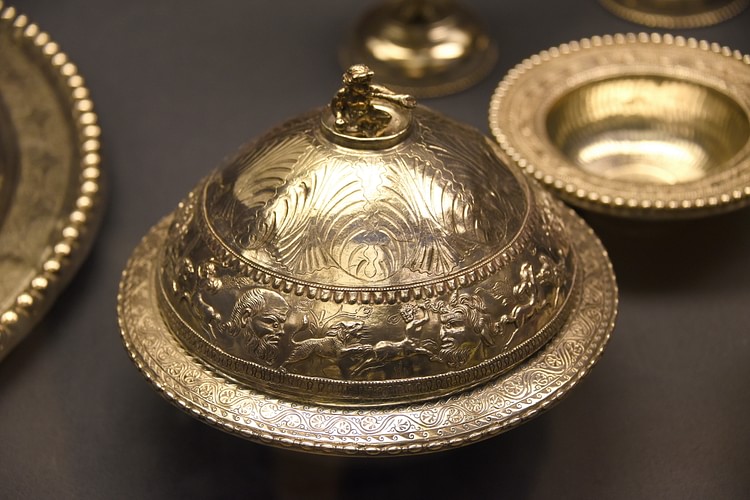
Silver had great value and aesthetic appeal in many ancient cultures where it was used to make jewellery, tableware, figurines, ritual objects and rough-cut pieces known as hacksilver which could be used in trade or to store wealth. The metal of choice to mint coinage for long periods, acquisition of silver mines in such places as Greece, Spain, Italy, and Anatolia was an important factor in many an ancient conflict. The metal was also found, amongst other places, in mines in ancient China, Korea, Japan, and South America where it was transformed into beautifully-crafted objects for elite use and to give as tribute and prestige gifts between states. Easily mined, worked, reusable, and brilliantly shiny, silver was one of the few truly international commodities which both connected and divided the ancient world.
PROPERTIES & MINING
Silver (Ag) is a soft metal which can be polished to produce an appealing lustre, two factors which made it ideal for ancient metalworkers to employ in their production of high-value goods. Silver was mined and smelted from ores such as lead carbonate (PbCO3) and galena (PbS). Ores usually contain less than 1% silver, but their abundance and lack of difficulty in smelting ensured ancient mining of the metal could be profitable, even from the Early Bronze Age. Smelting techniques improved over the centuries so that by the Classical period in Europe even low-grade ore could be exploited for the minute quantities of metal it contained. Indeed, smelting techniques made such progress that by Roman times it was possible to return to ore already treated (slag) in order to extract more silver from it. To strengthen the metal it was often alloyed with copper.
FOR THE INCAS SILVER WAS THOUGHT OF AS THE TEARS OF THE MOON.
Mining of silver in the Americas was largely done by digging vertical shafts into the ground. These tended to be shallow and so many were dug along an area of silver-bearing ore. Individual horizontal shafts were similarly short, only around one metre in length. Broken up using antler tools, the ore was crushed and smelted in clay crucibles. The Americas did not have bellows, and so the high temperatures needed for smelting were usually provided by several people blowing into the fire through tubes.As elsewhere, charcoal was used as the fuel source. Andean metalworkers were specialists at silver-plating and at producing alloys which mixed silver with gold, copper, and even platinum. Finished works were then often gilded or even painted.
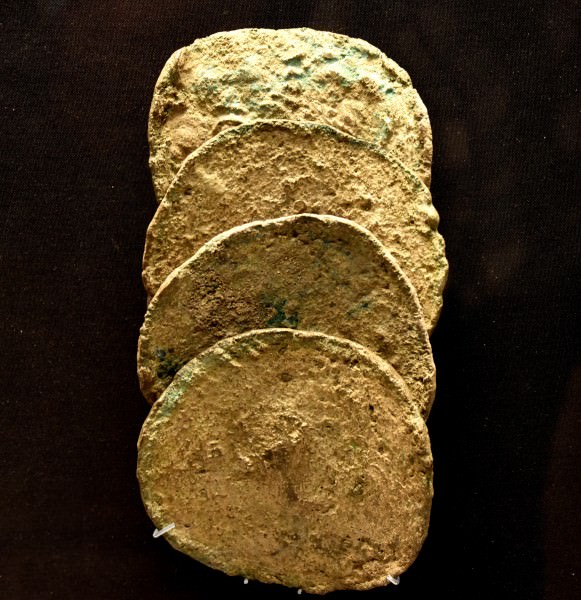
Silver Ingots from Syria
GEOGRAPHICAL AVAILABILITY
In Mesopotamia silver was used from the 4th millennium BCE. With no deposits in the area, silver was imported from Anatolia, Armenia, and Iran. Cities like Ugarit, Sumer, and Babylon used silver as a standard value measure with workers, for example, being paid in a specific weight of silver or its equivalent value in cereals. The Egyptians also valued silver and likewise acquired it through trade from Predynastic times, although silver archaeological finds are rarer than in other ancient cultures. This is perhaps because the Egyptians had their own sources of gold and only limited indigenous sources of silver.Certainly, silver was much closer in value to gold in ancient Egypt compared to other ancient cultures (1:2 instead of the more typical 1:13), and there were periods when it was considered even more valuable. In the Aegean, the Early Bronze Age cultures used silver which was mined from Attica (especially Laurion), the Cyclades, Thrace, and ancient Macedonia.
The Phoenicians, perhaps the greatest traders of them all, spread the use of silver even further across the ancient Mediterranean and channelled tons of it to western Asia, especially Assyria, mostly in the form of bullion (ingots, disks, and rings). The Phoenicians acquired such quantities that they earned an admonishing reference in the Bible : " Tyre heaped up silver" (Zechariah 9:2-3). To guarantee the weight and value, bars were stamped with official hallmarks. A Phoenician talent of silver weighed around 30 kilos and was worth 300 shekels. One silver shekel was worth 300 copper shekels and 227 shekels of tin. Gold was worth four times more than silver. Supply and demand affected the value of commodities just as they do today, and the oversupply of silver to the Near East caused a crash in the value of silver by the 6th century BCE.
Classical Athens benefitted from hitting a huge new seam on Mt. Pangaeus in Thrace, and both Carthage and Rome had a ready supply form Iberian mines and those on Sardinia. Indeed, the Romans worked some 40,000 slaves in the silver mines of Spain. The Etruscans did not go without, either, for they had access to silver in the north of their territory in Italy. By the later Roman period, as the empire expanded, silver was extracted from Britain, Germany, and the Balkans. Traded as coinage with peoples in India in exchange for spices and luxury goods, it was then converted back into bullion.
In the East, China's silver mines were exploited in the south from the 8th century CE, which led to the metal replacing silk as the primary method of bulk payment by merchants. In ancient Japan, silver was not extensively mined until the 16th century CE, but when it was, the metal became a handy method of payment with Portuguese traders who then spent it soon enough in their trade with China. So much silver went into the pockets of European traders - 20 tons a year - and the mines were worked out to such an extent that the Japanese government limited the silver taken out of the country from 1668 CE.
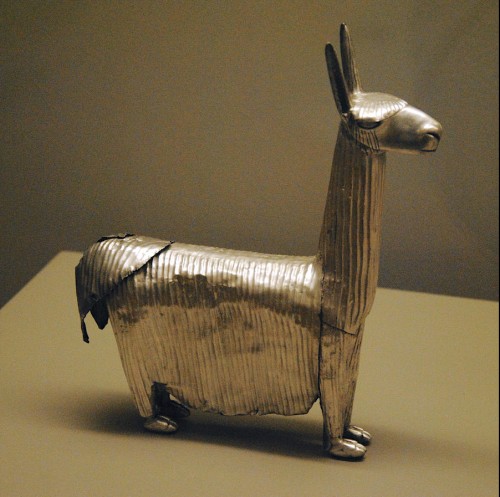
Inca Silver Alpaca
In the Americas, while the ancient Maya had plenty of gold, they had no silver of their own to speak of, but it was found in abundance further south, in the empires of the Incas and their predecessors. With plentiful supplies mined from northern South America (Colombia and Ecuador especially), the Moche, Wari, Lambayeque, and Chimu cultures all produced silverwork of the highest quality. For the Inca, just as gold was considered the sweat of the Sun, silver was thought of as the tears of the Moon. The rarity and prestige of the metal meant that it was restricted to use by the nobility; commoners had to make do with goods made from copper or bronze.
USES OF SILVER
Not as valuable as gold, silver was, nevertheless, used for much the same purposes but on a grander scale. Most ancient cultures benefitted from specialised craftsmen, often working for the royal household and given a dedicated area of the city to produce their shiny wonders. Jewellery, utensils, vessels, dishes, pepper castors, saucepans, figurines, masks, and decorative objects were made in silver. Silver, because of its high value, was widely used in objects related to religious rituals such as incense burners, relics containers, and votive offerings or dedications. Textiles were embroidered with silver thread, and items of clothing had pieces of silver sewn onto them. The metal was also widely used as an inlay material in such items as weapons, armour, furniture, and metal vessels.
HACKSILVER
Long before coins came along, silver in the form of ingots and rough cut pieces was a common method of payment for traders and states alike. This latter form, known as hacksilver (or hacksilber), was also used as a method to store wealth and was frequently buried, leading to spectacular archaeological finds of long-hidden hoards. Being roughly cut off from old jewellery, ingots, and basically anything made from pure silver, it was weighed each time a transaction was made, which often resulted in pieces being cut again and again to meet the exact weight required and, as a result, the pieces became ever smaller. The practice was common in the Near East, Egypt, and the ancient western Mediterranean up to the 4th century BCE when coinage largely replaced it. Hacksilver and silver ingots of no particular standardised weight were used in ancient India from the 8th to 7th century BCE. Small bent bars are typical, and judging by their differing weights, smaller pieces were probably cut from them before coinage became common.

The Taranto Hoard
Many hacksilver hoards include silver coins and so illustrate the gradual transition from one form of wealth storage to another.Spain, in particular, was an area where the habit of using hacksilver lingered on well into the 1st century BCE. With the demise of the Roman empire coinage production fell dramatically and hacksilver was, once again, the primary means to keep wealth and pay for goods. The Vikings, especially, were great savers of chopped up silver bits if the quantity of hoards discovered across central Europe, Britain, and Scandinavia are anything to go by.
SILVER COINAGE
One of the most common uses of silver throughout antiquity was as coinage. During the 6th century BCE, the first coins were minted in Lydia, which were made of electrum, a natural alloy of gold and silver, or of pure gold or pure silver. They were stamped with a design by the state as a mark of their authenticity and weight.
The first Greek coins appeared at Aegina c. 600 BCE (or even earlier), which were silver and used a turtle design as a symbol of the city's prosperity based on maritime trade. Athens and Corinth soon followed Aegina's lead. Heated discs of silver were hammered between two dies engraved with the designs. The birth of coinage in wider Greece, though, was not really an invention of convenience but a necessity, driven by the need to pay mercenary soldiers. These warriors required a convenient way to carry their wages, and the state needed a method of payment they could equally apply to everyone.
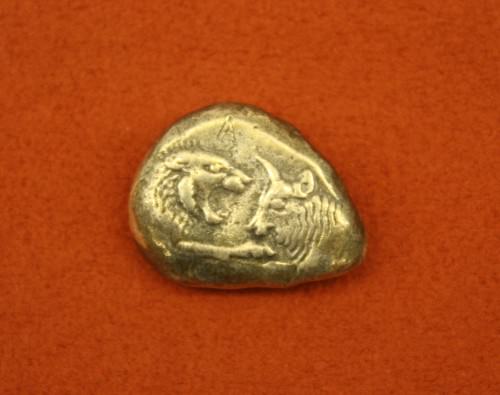
Lydian Silver Stater
Around 510 BCE Darius I introduced coinage in Persia, which included the silver shekel which weighed around 5.5 grammes.The master traders the Phoenicians long preferred the universal acceptability of silver bullion wherever their trade tentacles reached but, eventually, they too succumbed to progress. The first Phoenician coins were minted at Kition c. 500 BCE, then at Byblos c. 470 BCE. Other cities soon followed suit, Sidon and Tyre introducing silver coins around 450 BCE.
Coinage solved one problem but posed another, raising the interesting question of metal purity. The ancients were not aware of the concept of elements and their inherent properties, but smelters, through the necessity of creating coinage that was of a standardised weight, did manage to reach a purity of silver of around 98%. Silver coins were of relatively high value, perhaps equal to one week's work for most citizens. Only in the Hellenistic Period did smaller denominations become more widespread.
The first Roman silver coins were produced from the early 3rd century BCE and resembled contemporary Greek coins. C. 211 BCE a whole new coinage system was introduced. Appearing for the first time was the silver denarius (pl. denarii), a coin that would be the principal silver coin of Rome until the 3rd century CE. Following the acquisition of the silver mines in Macedonia from 167 BCE, there was a huge boom in silver coins from 157 BCE. Gradually, as emperors spent more frivolously and wars drained the state coffers, silver coins went from almost pure to 70% then 50% and on down until they reached an all-time low of just 2% silver content.
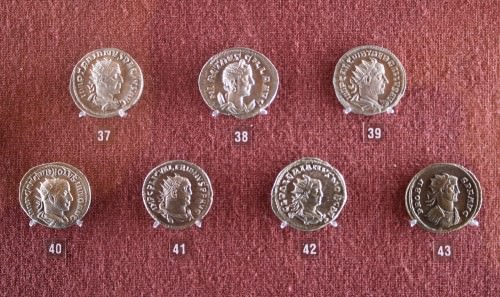
Roman Empire Silver Coins
Chinese coins, with their distinctive square central hole, were first produced in the second half of the first millennia BCE, but they were always made of copper. Coinage arrived in ancient India around the 6th century BCE. The ancient Americas had no coinage, but silver, like other precious materials such as gold and textiles, was used for trading purposes. Silver was highly valued and goods made from it were used as gifts and tribute, but their specific value depended on each item and the context in which it was given.
One final form of currency, in use in Korea from the 12th to 14th century CE, was the unbyong silver vase, stamped by the state and given an official rate of exchange with staple commodities such as rice; it was shaped like the peninsula of Korea.Unfortunately, no examples survive, but we do know from a 1282 CE law that the value of one unbyong was fixed at between 2,700 and 3,400 litres of rice. Despite their impracticality for smaller transactions, the vases continued to be used over the next two centuries, until King Chungyol permitted rough or broken pieces of silver to be used instead at the end of the 13th century CE.
LICENSE:
Article based on information obtained from these sources:with permission from the Website Ancient History Encyclopedia
Content is available under License Creative Commons: Attribution-NonCommercial-ShareAlike 3.0 Unported. CC-BY-NC-SA License